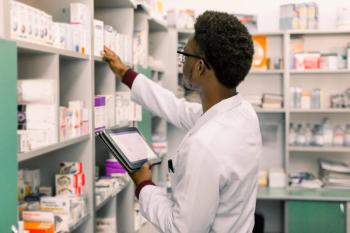
POC Testing Opportunities Are Important Beyond COVID-19
Independent pharmacies can turn this opportunity into a revenue strem
The COVID-19 pandemic has highlighted the unique role pharmacies can play in promoting
public health in their communities. With health care trends constantly evolving, there is no better time for community pharmacies to build a point-of-care (POC) testing practice. Although most independent pharmacies are offering COVID-19 and influenza vaccines, so much more can
be done to bring in new customers and increase revenue.
Paige Clark, vice president of pharmacy programs and policy at Prescriptive Health, who spent the past 11 years at Oregon State University College of Pharmacy, is passionate about pharmacists expanding their scope of practice and is a champion of POC testing for
independent pharmacies. “Given the role they play in their community, [and] the convenience that having these services done at their local independent pharmacy provides [to patients], pharmacists should definitely look to these services,” she said. “Momentum is with
us now in the community pharmacy settings again from a public health standpoint. We clearly haven’t seen anything like this pandemic before and it has just massively extrapolated the
visibility and the functionality that our retail pharmacies play in the overall
health care ecosystem.”
Beth Bryan, PharmD, pharmacist and owner of Surgoinsville Pharmacy in Surgoinsville, Tennessee, noted that the pandemic has instigated practice changes for all medical offices. “Medical practices across the nation implemented new protocols, from temperature checks
and mask protocols to COVID-19 testing and vaccinations,” she said. “So there couldn’t be a better time for pharmacies to consider implementing [POC] testing in their practice.”
Community pharmacies are among the most accessible health care destinations in the country. According to the CDC, more than 90% of the population lives within 5 miles of a community
pharmacy and an estimated 77% of community pharmacies operate in populations of less than 50,000.
Getting Started
To get started in POC testing, there needs to be an assessment of the pharmacy
practice to see which tests would make the most sense for the pharmacy and
the population that it serves, Bryan explained. “Then, I would recommend a training program for the start to learn about testing procedures and allow for certification for the staff performing
the tests,” she said. “As soon as the pharmacy decides which test(s) they want to provide, they need to apply for a CLIA [Clinical Laboratory Improvement Amendment] waiver. Additional
tests can be added later if the pharmacy decides to do more or grow their testing program.”
Independent pharmacists can get their CLIA Certificate of Waiver by submitting the application (Form CMS-116) to the appropriate state agency.
Lisa Faast, PharmD, CEO of DiversifyRx, noted that every state is different; pharmacists
cannot necessarily rely on what they have heard from someone else in the business.
“The next step is to ensure that you have the appropriate Provider Transaction Access Number [PTAN] for billing CMS [Centers for Medicare & Medicaid Services] for these tests as a clinical
laboratory,” said Jason Ausili, PharmD, chief clinical o. cer, FDS. “This is different from the typical mass immunizer or pharmacy PTANs that pharmacies are accustomed to,” he added.
Finally, pharmacies will want to ensure they have a seamless medical billing platform
in place that allows them to submit the appropriate codes for reimbursement to the medical plan.
More Than COVID-19 and Flu
The most popular POC services that pharmacies provide are for influenza, streptococcus, and now COVID-19 testing. These tests are a good fit for pharmacies; they are attractive to
patients because of the quick turnaround and easy access. Because POC tests are relatively inexpensive, they are very affordable for patients and often cheaper than a co-pay for urgent
care or emergency department visits.
There are hundreds of tests that pharmacies can provide under the CLIA waiver. Bryan asserted that pharmacies should quickly add strep and urinary tract infection (UTI) testing because they
would appeal to patients needing a fast diagnosis and treatment option.
“Another good option to consider is [hemoglobin] A1C testing, especially if the pharmacy offers any diabetes services such as counseling, education classes, or diabetes prevention programs,” Bryan said. “A pharmacy can also consider cholesterol screening to add to its disease management programs such as MTM, hypertension management, and risk-assessment programs.”
Community pharmacies, Ausili noted, are ideally suited to administer CLIA waived
tests that screen for infectious diseases as well as those that aid in chronic disease monitoring. Under the public health emergency (PHE), pharmacists are authorized to order and administer
COVID-19 tests and influenza or respiratory syncytial virus tests if done in conjunction with a COVID-19 test.
Several states have adopted legislation during the PHE that gives pharmacists this privilege moving forward. In addition to screening for infectious diseases and monitoring chronic
diseases, community pharmacies have a key role in “test and treat” programs for conditions like group A strep and influenza.
“Patients who are experiencing the symptoms of strep and flu typically turn up at urgent care, emergency [departments], or do not seek care at all,” said Ausili. “This often leads to the patient
receiving a much higher level of care than needed, or the increased risk of community spread.”
Community pharmacies o.er a convenient, effective alternative that takes pressure overburdened primary care and emergency care channels. Kentucky, for example, has a statewide protocol
supporting pharmacy-driven “test and treat” programs and has improved access to quality care for residents.
Benefits to All
Some pharmacists are hesitant about POC tests because they do not know whether
their patients want it or will pay for it, according to Faast. “They have this uncertainty that they will go out and buy this test and they don’t know whether they are throwing money away
or whether their patients are interested in paying for the tests,” Faast said.
Still, she recommends pharmacists start with POC tests for cholesterol panels, hepatitis, HIV, A1C, UTI, and INR, and believes most will find success. “The ultimate benefit is for the patient—the more that they can get a clear path on how to feel better is good for all,” she
said.
For pharmacies, the bottom-line benefit is increasing profitability and lessening reliance on pharmacy benefit managers (PBMs). “Obviously, everybody associates pharmacists with their drugs, but I think the more that we can start to associate pharmacists with more clinical-
based activities, I think the better off it’s going to be for the community and the profession,” said Faast.
Money Matters
POC testing is predicted to exceed immunizations as a driver of revenue for community pharmacies, according to research from Deloitte. Although research has shown tremendous growth in the number of pharmacies becoming CLIA-waived facilities, highlighting
a 45% increase between 2015 and 2020, so far, very few pharmacies have taken
this leap.
The ROI is an important consideration for pharmacists as they add POC testing. Clark explained that pharmacists start in the cash lane and crack open the Medicaid lane for reimbursement,
which then opens the door for the commercial lanes. Pharmacies will
need a medical billing solution that seamlessly integrates with their normal
workflow to bill and get reimbursed for these tests.
“A billing solution that does not deviate from pharmacy workflow will
provide a more effcient billing experience for community pharmacies while
enabling them to get paid as a provider for services versus a dispenser of services,” he said.
“Because these claims go directly to the medical benefit and not the PBM, pharmacies will maximize reimbursement and administration fees by being recognized as a provider.”
Medical billing is a possibility with POC testing but not required for pharmacies to offer testing to their patients, according to Bryan. “Most testing options are completely affordable to patients and billing isn’t a huge concern for the general public,” she said. “There is the option for the patient to file a paper form or use their flex spending cards to cover the costs. To bill medically,
the pharmacy will be required to individually contract with the insurance providers, as well as implement an electronic platform for processing claims.”
Getting the Word Out
For independent pharmacists to get the most out of their POC testing, they need to let people in their community know they are offering these services. Faast recommended utilizing social media and Facebook Live to connect to individuals and get more eyes on websites advertising
the new testing. “Educating in an entertaining, personal, authentic way will drive more traffic,” she said.
Newsletter
Pharmacy practice is always changing. Stay ahead of the curve with the Drug Topics newsletter and get the latest drug information, industry trends, and patient care tips.
















































































































